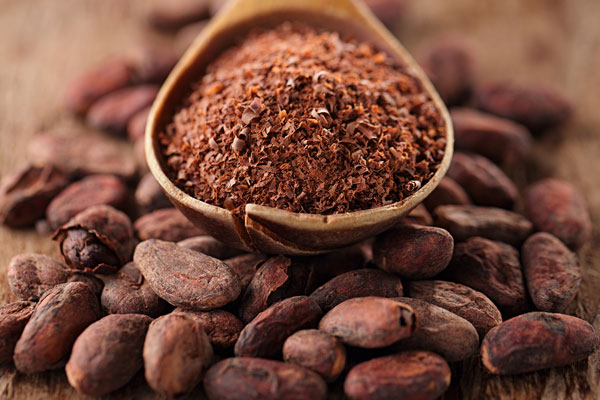Cocoa (Theobroma Cacao) L.
Family - Sterculiaceae
The world demand for cocoa is on the increase and future prospects for exports of cocoa from Sri Lanka will be better. It is envisaged that the area under cocoa could be increased by 5,000 hectares. Suitable conditions for growing cocoa are found in the Central, North Western, Sabaragamuwa, Uva, Western and Southern provinces up to 600m elevation. Cocoa can be considered the most important tree crop for underplanting coconut and rubber provided suitable soils exist.
Cultivation
Agronomic Requirements for cultivation
The best soils for cocoa are deep, well drained clay loams rich in organic matter. The pH of the soils could range from 5.0 - 6.5 but growth is best at pH 6.0 - 6.5. Cocoa thrives best under moist, humid conditions. A high level of humidity is particularly important during flowering as it favours pollination. An evenly distributed rainfall of over 1650 mm per annum is essential to maintain a high level of humidity. However, rainfall exceeding 2750 mm/annum would favour fungal diseases especially pod rot. The annual average temperature should be in the range of 24 - 27°C without much diurnal fluctuation or seasonal variation. Frequent winds are harmful as this decreases humidity. Sheltered valleys and levered slopes are therefore the best situations for growing Cocoa.
Shade is closely associated with rainfall and humidity of the area. Relatively dense overhead shade (40 - 50% full sunlight) is essential at the time of planting and during the first 3 years of growth.

Recommended Varieties
Criollo, Forastero and Trinitario are the three types in Cocoa. They have been categorized according to the colour of the cotyledon, etc.
Criollo - Creamy white colour cotyledon. This type holds fewer potion of the traded cocoa but the cocoa is of fine or flavor type
Forastero - Dark purple colour cotyledon. Yield well and more resistant to pest and diseases. Bulk of the traded Cocoa holds by this type.
Trinitario - A hybrid. Cotyledon colour range from creamy white to purple with an array of intermediate colours.
Two Cocoa Hybrids namely SCA6 x ICS6 and NA32 x ICSI have been introduce by the research division of the Department of Export Agriculture.
Field Planting and Spacing
Propagation can be either by seed or by vegetative means. Hardened seedlings will be ready for planting in the field about 4 months after sawing in polythene bags. The standard number of cocoa is 1100, planted at 3 m x 3 m spacing. Cocoa can be intercropped with several perennials such as coconut, Rubber, Pepper and Banana.
Manuring
The following fertilizer mixture and rates of applications are recommended.
| Components | Parts by weight | Nutrients in the Mixture |
| Urea (46% N) | 4 | 14 % N |
| Rock Phosphate (28% P2O5) | 5 | 11 % P2O5 |
| Muriate of Potash (60% K2O) | 3 | 14 % K2O |
| Kieserite (24% MgO) | 1 | 2% MgO |
Application rates per plant
| Years | g / plant / season | kg / ha / season | Total applic. kg / ha / year |
| 1st Year | 63 | 70 | 140 |
| 2nd Year | 250 | 278 | 555 |
| 3rd Year onward (Minimum) | 350 | 309 | 777 |
Harvesting and Processing
Cocoa tree comes into bearing in the 4th year. The fruit/pod takes about 5 months to develop into maturity. Orange or yellow colour pods must be harvested. As soon as possible after picking, the pods must be opened and beans must be collected and fermented. If they are not properly fermented cocoa beans have little commercial value.
Quality Requirement
Standard Specifications for Grading of Cocoa beans
External Appearance
The beans should be well rounded in shape with the seed coat loose and intact. Flat, shrivelled germinated, mouldy, insect damage or other defective beans are not acceptable.
Internal Appearance
when cut lengthwise, the internal surface should be fissured and of a dark chocolate' brown (Forestero Type) or cinnamon brown colour (criollo type).
Texture - The cotyledons should not be leathery. They should be brittle.
Beans Size - Not more than 990 dry beans per Kg for Grade I.
There are 6 grades of cocoa beans according to the specifications given by the Sri Lanka standards Institution (SLS 106:19977)
| Grades | External Colour | Mouldybeans Max.% | Slatybeans Max.% | Defective beans Max. % |
Foreign matter Max. % |
Moisture content Max. % |
| Grade I | Pinkish red to brown | 4 | 3 | 3 | 0.5 | 7.5 |
| Grade II | Brown or reddish brown to blackish brown | 5 | 5 | 5 | 0.5 | 7.5 |
| Grade III | Brown to blackish brown | 12 | 8 | 10 | 0.5 | 7.5 |
| Blacks | 1 | 7.5 | ||||
| Garbling (defective beans) | 1 | 7.5 | ||||
| Meat or Rice (pieces) | 2 | 7.5 |

